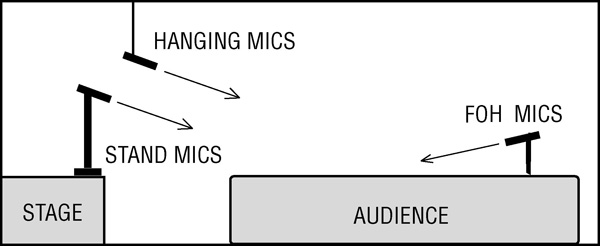Remote recording is exhilarating. Musicians, excited by the audience, often put on a stellar performance. Usually you only get one chance to get it recorded, and it must be done right.
It’s on the edge, but by the end of the night, especially if everything has gone as planned – what a great feeling!
Challenges abound. Monitors can feed back and/or leak into the vocal microphones, coloring the sound. Bass sound can leak into the drum mics, and the drums can leak into the piano mics. Then there are other mic-related gremlins such as breath pops, lighting buzzes, wireless system glitches, and more.
How to get around the potential problems? Let’s have a look at some effective mic techniques that work well when recording in the live realm. And note that these are tailored more to “pop-style” music performances.
Position omnidirectional mics close to the source. Close miking increases the sound level at the mic, so less gain is needed, which in turn cuts background noise and leakage.
Use unidirectional mics. Cardioid, supercardioid, hypercardioid models reduce leakage and feedback by attenuating off-axis sounds. Also, their proximity effect boosts the bass up close, without boosting the bass of distant sounds.
Use direct boxes and guitar pickups to eliminate leakage. Or use pickups mixed with mics.
Use a pickup for the stage monitors and a mic for the house loudspeakers. Here’s a trick to reduce feedback while attaining quality sound. If miking an acoustic instrument that has an internal pickup, send the pickup signal only to the monitor loudspeakers, and send the mic signal only to the house loudspeakers.
Specifically, in the mixer’s pickup channel, turn up the monitor send and turn down the fader. In the mixer’s mic channel, turn down the monitor send and turn up the fader. That way, the pickup prevents feedback from the floor monitors, while the mic provides a natural sound to the audience.
Try headworn noise-canceling mics on vocals. A noise-canceling or differential mic is designed to cancel sounds at a distance, such as instruments on stage or monitor loudspeakers. These mics can provide very good gain-before-feedback and isolation. Note that the mic must be used with lips touching the foam windscreen, or otherwise the voice is cancelled.
Use wireless mic systems correctly. If dropouts can be heard, move the wireless receivers (or remote antennas) where a stronger signal can be picked up. It may also help to put the receivers on stage. If distortion occurs with loud yelling, turn down the gain-trim pot in the affected mic.
Prevent hum and buzz. Keep mic cables well separated from lighting and power cables. If the cables must cross, do so at right angles to reduce the coupling between them, and separate them vertically. If hum pickup is severe with dynamic mics, use models that incorporate humbucking coils. Routinely check cables to make sure shields are connected at both ends. Tape over cracks between connectors to keep out dust and rain.
Try mini mics and clip-on holders. Nearly all manufacturers offer miniature condenser models, and sometimes these tiny units offer sound quality comparable to larger studio mics. If clipped on musical instruments, they reduce clutter on stage by eliminating boom stands, while also allowing performers to move freely around the stage. And because a miniature clip-on mic is very close to its instrument, it picks up a high sound level.
Often, omnidirectional mics can be used without feedback, and generally, they offer a wider, smoother response and pick up less mechanical vibration than unidirectional models.





















